Michael Jensen's Blog, page 2
November 28, 2024
A Magical Meal in Macedonia
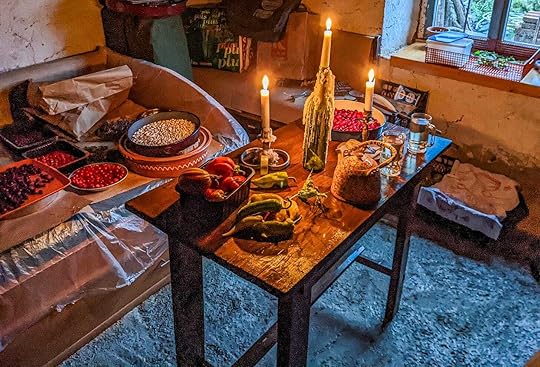
Happy Thanksgiving to all of my American subscribers, and a belated happy Thanksgiving to all the Canadian readers! (And hello to everyone else!)
This Thanksgiving Day, Brent and I are onboard the Sky Princess as we head back to the U.S. for the Christmas holidays.
Turkey, potatoes, and cranberries are on the ship’s menu for tonight, though I’m keeping my expectations in check about their quality.
Thanksgiving is a holiday I love for many reasons: crisp fall days, corn mazes and bright orange pumpkins, and the promise of Christmas right around the corner.
Alas, celebrating it outside the U.S. has never quite measured up, no matter how hard we try. I especially miss the smell of a roasting turkey filling the house, leftover turkey sandwiches, and football games.
Since I don’t have a heartwarming story about celebrating Thanksgiving while abroad, I wanted to share photos of what might be the best meal I’ve eaten over the past seven years.
It happened in the tiny village of Brežani in the remote mountains of North Macedonia, about an hour from where Brent and I were staying on Lake Ohrid in September of 2022.
 That’s Brežani way up in the mountains all by itself.
That’s Brežani way up in the mountains all by itself. A meal cooked entirely over a campfire and a single kerosene flame.
A magical meal.
It was set in motion one morning while I sat on a bench along the lake and struck up a conversation with Mitko, a local man who worked as a stained-glass artist.
Mitko and I chatted for a while, and before I knew it, he had invited me — and Brent, who was back at the apartment — to join them a few days later in Brežani. In this remote mountain village, he and his wife, Mimoza, had been slowly renovating an old, abandoned house.
So there we were in the back of a van winding our way up a dirt road to that remote mountain village.
 Kilometer after kilometer on this two-lane dirt track into the mountains. With strangers!
Kilometer after kilometer on this two-lane dirt track into the mountains. With strangers!It felt odd to trust a virtual stranger enough to do this, but I had visited Mitko’s studio, and it seemed pretty unlikely he was up to something nefarious.
On the other hand, it would make a great opening scene for a horror movie titled Macedonia Cannibal Massacre.
Hey, life is an adventure, right?
When we arrived at the village, it was in a small valley that was genuinely remote. And small. And mostly abandoned.
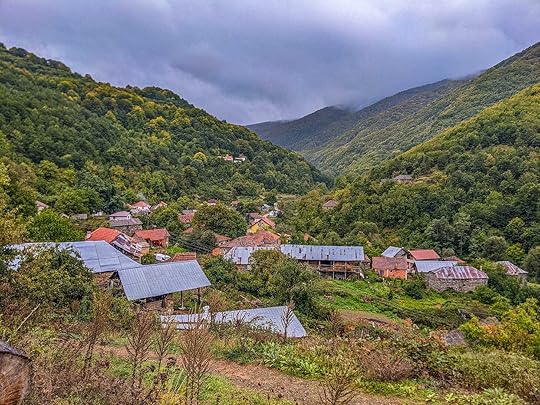 Brežani! And, yeah, that’s all of it.
Brežani! And, yeah, that’s all of it. Nestled in the Mokra Mountains, Brežani had once been a vibrant village of 700 people most living as farmers and shepherds.
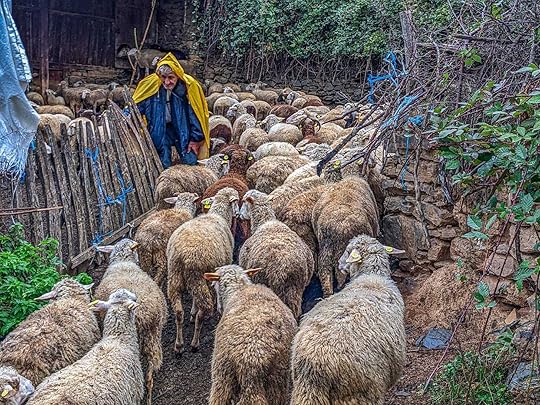 Jovan still lives in Brežani and tends to his flock.
Jovan still lives in Brežani and tends to his flock. Red peppers and tomatoes were essential and used in many traditional dishes, including ajvar, possibly the best condiment in the world.
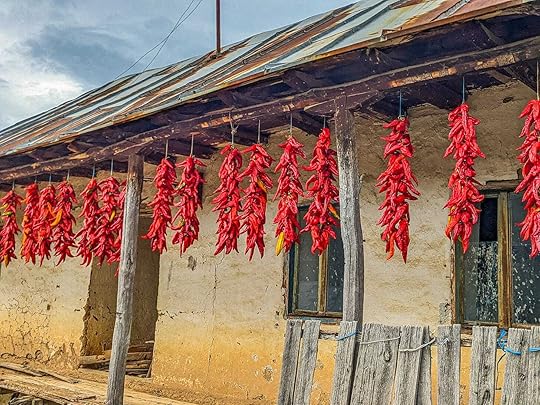 When fall arrives, red peppers are hung out to dry all over Macedonia.
When fall arrives, red peppers are hung out to dry all over Macedonia. However, grapes were also widely grown since they were used with plums to make rakia, a very popular drink throughout the Balkans.
 Ready to be harvested.
Ready to be harvested. Alas, over the years, Brežani dwindled to fewer than two dozen permanent residents as agriculture grew less important and young people drifted away for better opportunities and more exciting lives.
The harsh weather, neglect, and the years took their toll on the village.
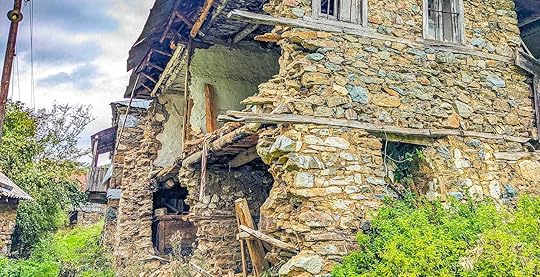 Not unusual in Brežani. Some houses have been abandoned for so long, they are completely covered with ivy.
Not unusual in Brežani. Some houses have been abandoned for so long, they are completely covered with ivy. As time passed, the village spiraled further into disrepair and abandonment.
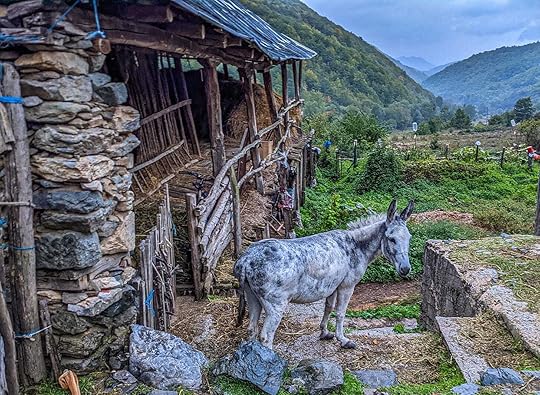 This fellow decided to stay.
This fellow decided to stay. However, not everyone left Brežani!
Marija, age 84, had remained in the same house where she and her husband raised their two sons. After her husband died and her boys moved to the city, Marija stayed in Brežani, tending her enormous garden — all alone.
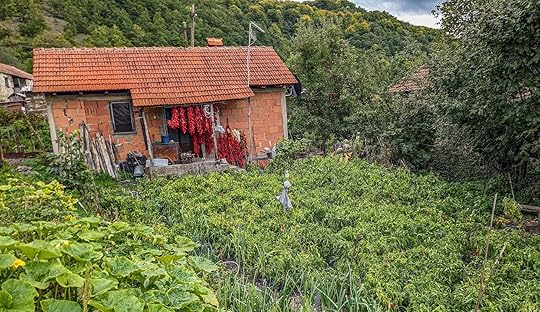 Mitko and Mimoza’s closest neighbor Marija.
Mitko and Mimoza’s closest neighbor Marija. So when Mitko and Mimoza wanted a simpler way of living, they decided Brežani was the place.
They purchased a derelict seventy-year-old house in the village and set about restoring it. Despite their work, it still didn’t have running water, electricity, or even a working toilet when we visited.
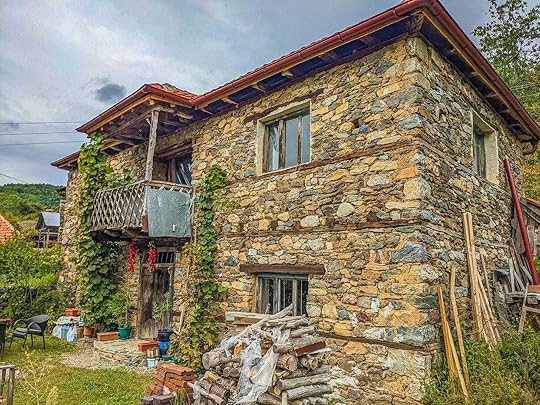 Built more than seventy years ago, the house had been badly neglected, but Mitko and Mimoza have worked hard to restore it.
Built more than seventy years ago, the house had been badly neglected, but Mitko and Mimoza have worked hard to restore it.When Mitko and Mimoza came up from Ohrid, where they currently lived, to work on the house, they slept in a tent.

They weren’t in any rush. For them, building a peaceful life in the village seemed almost as important as finishing the house.
So, on each visit, they did a little more work and, more importantly, savored the experience of being far from everything.
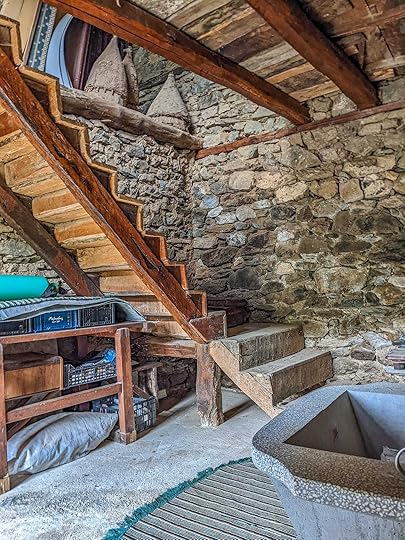 Rustic, but it’s going to be lovely when it’s finished.
Rustic, but it’s going to be lovely when it’s finished. So far the roof had been fixed and the outside walls patched up. The bottom floor had been cleaned up and had a rudimentary kitchen, but the upstairs was nothing but storage.
Time to start cooking! Everything was made from scratch.
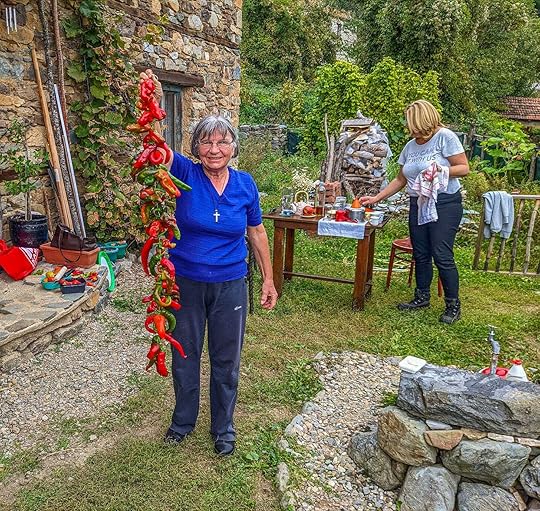 Mitko’s aunt holding the peppers, Mimoza to the right.
Mitko’s aunt holding the peppers, Mimoza to the right.First, they had to wash and prepare the tomatoes and peppers…

…and then roast the peppers over an open fire.
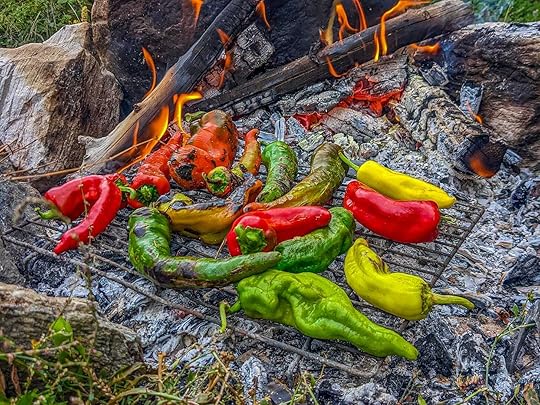
Have you ever smelled peppers roasting over an open fire in the mountains?
Oh, my god.
They have a smoky sweetness that perfumes the air. It made me feel like I’d returned to a simpler era.
We offered to help with the cooking but were told in no uncertain terms that, as guests, we were expected only to sip rakia and enjoy the food and company — which included other villagers who were constantly stopping by.
Except for Mitko and Mimoza, no one spoke English, but that didn’t matter. In the quiet of those Macedonian mountains, we could all still enjoy each other’s company.
 Throughout the day, villagers dropped by for a drink and a chat.
Throughout the day, villagers dropped by for a drink and a chat. While Mimoza and Mitko’s aunt did most of the cooking, Mitko did a steady stream of chores: fetching water, keeping the fire going, picking vegetables, and more.
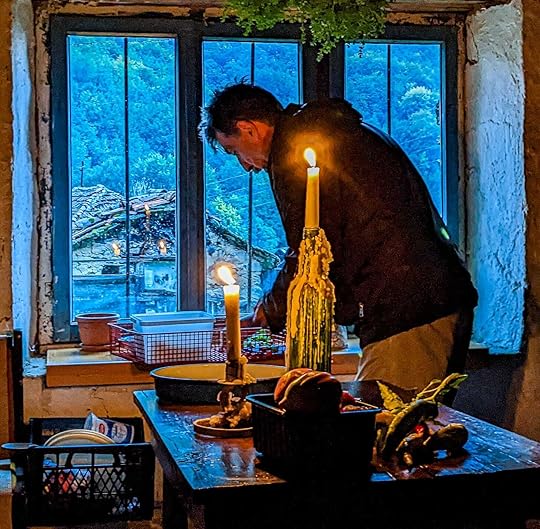 Mitko hard at work.
Mitko hard at work. Then the food started coming. First, a tomato and onion salad, using tomatoes so fresh they burst with sweetness offset by a dash of vinegar.
Of course, we had to have rakia with it. But be careful! This alcohol is potent stuff!
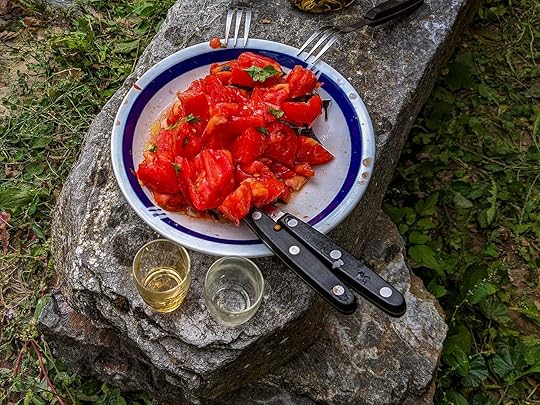
Assuming the weather held on an already cloudy day, the plan was to eat outside.
Looking at the table, I felt like I’d stepped into a dinner party in a foreign film where everyone would be impossibly witty, and the conversation would flow like, well, rakia.

Meanwhile, inside the house, Mimoza continued to prepare the main meal.
I peeked through the window.

I wanted a better look, so I snuck inside — and felt like I’d stumbled into a painting by some long-dead European master.

One table was filled with shelled white beans and pans and bowls of forest fruit Mitko and Mimoza had harvested on our way up to Brežani.
Food didn’t come any more fresh than this.
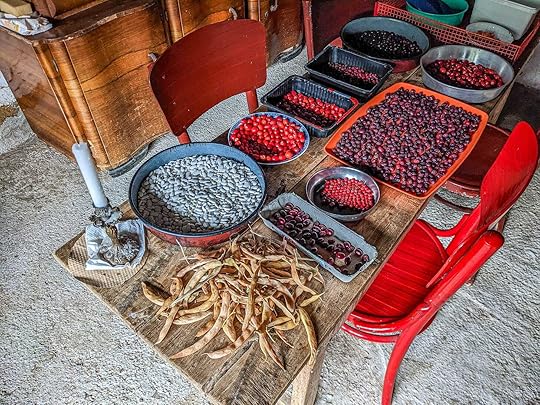
Then there was the smell inside the house! Carmelized onions! Garlic sizzling in oil! Simmering meat!
Using only a single propane burner, Mimoza had somehow prepared a feast.
There was turlitava, a traditional Balkan stew cooked in an earthenware pot.

Mimoza told me this dish included pork, beef, and lamb, plus onion, peppers, potato, green beans, okra, parsley, garlic, tomato, and carrots, all simmered together for hours.
Then, there were the roasted peppers, which were seasoned with oil, vinegar, and garlic.

There was also tavče gravče, beans baked in the oven; komad, a pie with cheese and eggs; gibanica, pastry sheets stuffed with cheese, sour cream, and eggs; proja, a bread made with corn flour, leeks, and, yes, more cheese; and a simple cucumber salad.
And, of course, ajvar, the roasted red pepper dish about which Macedonians are (correctly) passionate.
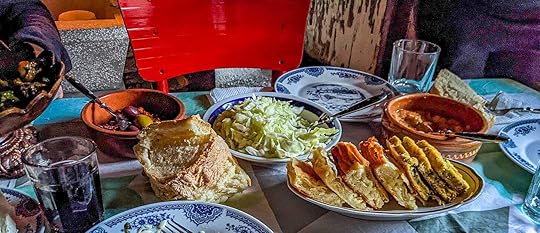
Unfortunately, our luck with the weather ran out, and we had to move everything indoors because of rain.
I won’t lie. I was disappointed because eating outside in a tiny Macedonian valley sounded incredibly romantic — especially compared to eating inside a house far from livable.
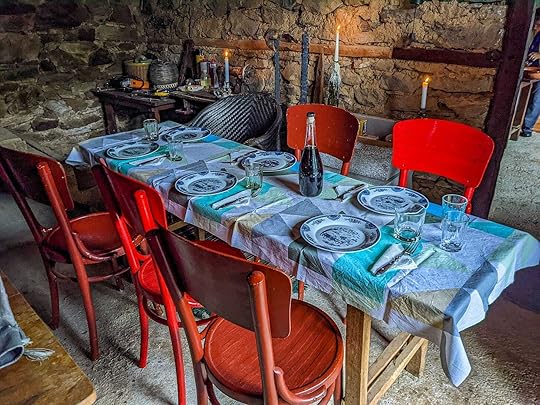
But I was wrong.
The magic of that Macedonian day persisted because once the candles were lit, the food laid out, and our new friends gathered around the table, everything was…

…perfect.
The dishes were some of the most flavorful I’d ever eaten. The turlitava was rich and hearty, the peppers grilled to sweet, smoky perfection, everything bursting with freshness and flavor.
Even in the finest restaurant, you couldn’t buy a meal like this.
As we finished the last of it, I looked around the table and thought, This is why we travel.
To meet people like Mitko and Mimoza. To venture to remote mountain villages and eat food that connected us directly to Brežani’s bygone days.
Sure, we’d soon be missing another Thanksgiving Day back in the States, but I didn’t care. I could still be thankful — and now I had so much more to be thankful for.
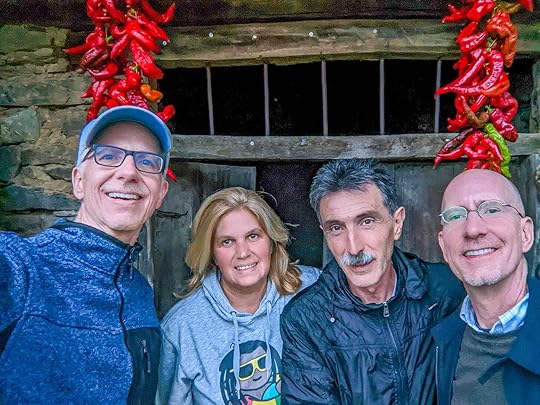 Brent and I with Mimoza and Mitko.
Brent and I with Mimoza and Mitko. If you enjoyed this newsletter, I would appreciate your sharing it with someone you think might also like it.
Michael Jensen is a travel writer, amateur photographer, and novelist. Check out his other newsletter about his travels at BrentAndMichaelAreGoingPlaces.com.
November 13, 2024
Let's Go On a London Pub Crawl!
During our stay in London two years ago, I absolutely fell in love with the city’s pubs.
I wrote a newsletter about how much I adored them.
What frustrated me about that article was that I could only include a handful of the photos I’d taken, and most were collages like this.

Boo! That doesn’t really give readers a sense of how gorgeous these pubs are. And many of my favorite pictures never saw the light of day.
Now, with Michael Takes Too Many Pictures, I can rectify that.
But I’m not simply going to show you a bunch of photos.
No, no, no.
Instead, we’re going on a virtual pub crawl to some of my favorite London pubs. And we’re going to drink ourselves silly along the way.
Please note: these are not just any pubs. They’re some of London’s best “theme” pubs.
What’s a theme pub? It’s awesome, is what it is!
Okay, I’ll be more specific: a theme pub uses its decor, menu, and ambiance to create a unique, immersive experience.
Hmm, that sounds kind of boring. Clearly, I should just show you what a theme pub is.
So off we go!
OLD BANK OF ENGLANDAddress: 194 Fleet St, London
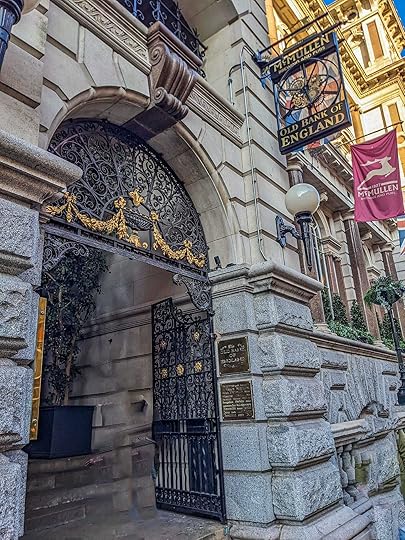
That’s pretty fancy and stuffy looking for a pub, innit? Let’s go inside and check it out anyway.
There’s the bar, and, yeah, this place does look pretty swank. Let’s have our first drink, shall we?

I love ciders, which the Brits do quite well. Mmmm, this one is quite tasty.
This gorgeous building dates back to 1888, when it was the closest branch of the Bank of England to the Royal Courts of Justice. Maybe that’s why it has such a hoity-toity feel.
But check out these chandeliers. I love the golden light bathing the interior.

The bank’s vaults once stored a lot of gold — and supposedly even the Crown Jewels. The grand interior is Victorian, which explains the ornate chandeliers, high ceilings, and intricate woodwork.

The original bank was converted into a pub in 1994, undergoing extensive renovations that kept many elements that make this pub so iconic.
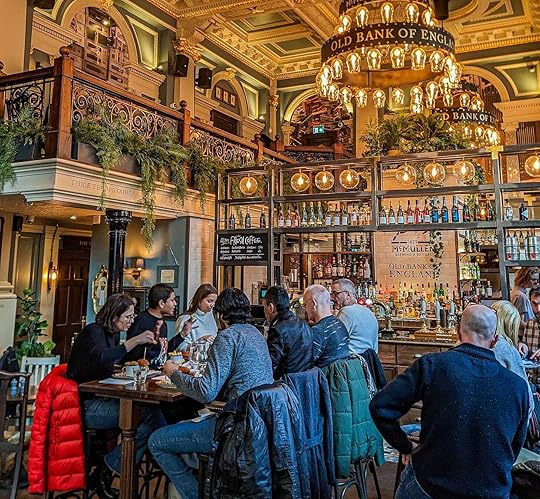
Given its original use as a bank, it’s not surprising this pub doesn’t have the homey feel of a more traditional pub. But come on, this place is gorgeous.

Okay, finish up those drinks. We’ve got a schedule to drink, er, keep. Let’s go!
THE BLACK FRIAR PUBAddress: 174 Queen Victoria St, London
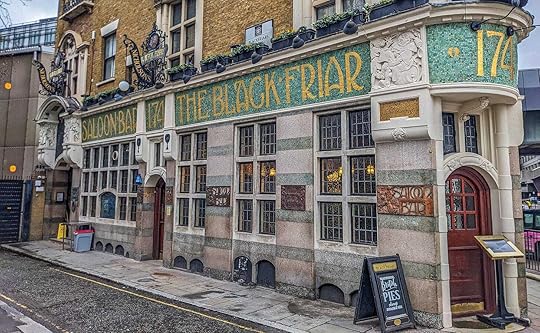
Our second stop is the Black Friar Pub.
Time for our second drink. Mmm, still refreshing!
The Black Friar was built in 1875 on the site of a former Dominican friary. It’s especially well known for its Art Nouveau style, including the intricate mosaics on the exterior and the stained glass inside.
The interior was reimagined and redone in 1905 by architect Herbert Fuller-Clark and artist Henry Poole. The highlights are the copper reliefs depicting cheerful friars in scenes inspired by the friary's heritage.
In case you don’t know, a “friary” is where friars live, while a “monastery” is where, yes, monks live.
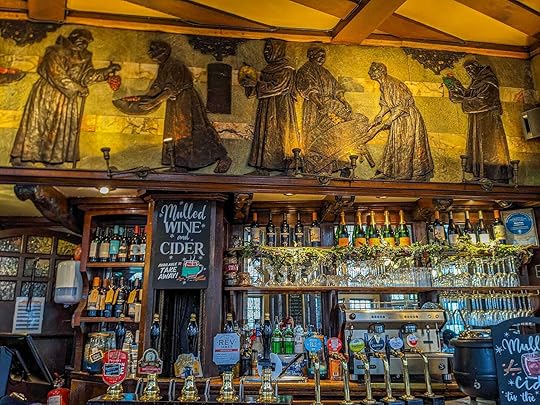
What’s the difference between a monk and a friar?
Monks live a more secluded life of prayer and contemplation, mostly staying inside a monastery’s walls. Meanwhile, friars lead more active lives, frequently engaging with the outside community.

Think Friar Tuck running around with Robin Hood and his band of Merry Men versus St. Benedict, who founded the Benedictine Order.
I definitely would have been a friar.
But friars and monks did have something in common. Both brewed beer! That makes this spot a perfect place for a pub today.
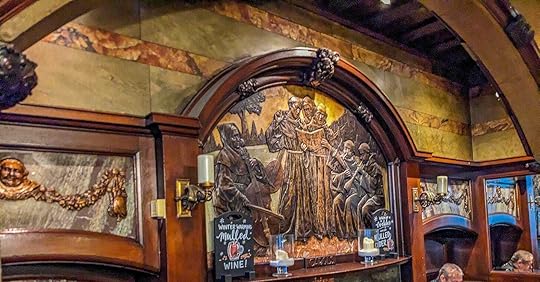
Monks and friars brewed beer as a way to be self-sufficient.
This also made them pretty important in medieval Europe, where water supplies were often contaminated, and beer wasn’t just safe to drink but also provided much-needed nutrition.
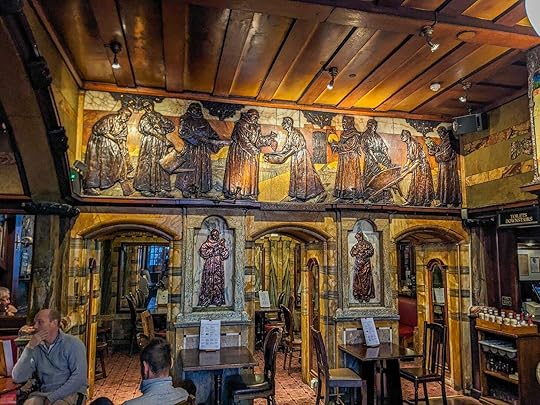
And you thought drinking was only for taking the edge off!
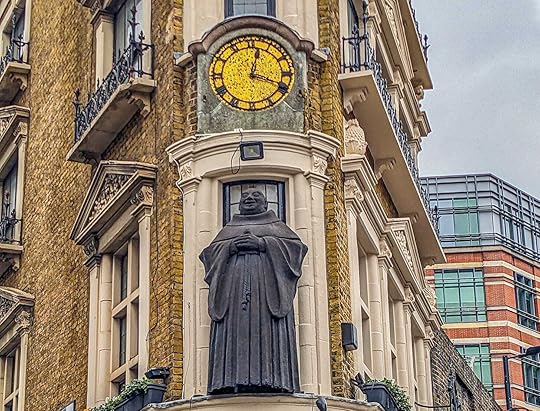
Okay, finish up your drinks. It’s time to move on!
THE SHERLOCK HOLMES PUBAddress: 10 Northumberland St, London

Are you ready for our next pub? Because the game is afoot!
You're probably not a Sherlock Holmes fan if you don’t recognize what I’m saying.
(In the otherwise excellent version starring Benedict Cumberbatch, Holmes offers a much more boring, “The game is on.)
Let’s head inside and get our drinks.

I normally have one cider every couple of weeks, so I’m already feeling a bit light-headed. But in for a penny, in for a pound! Or since we’re in England, should that be “in for a pence, in for a pound?”
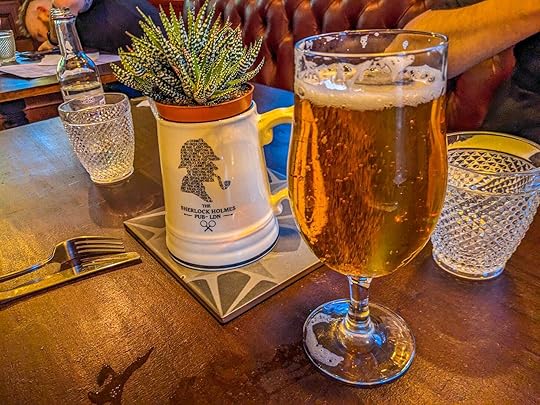
When I first heard about the Sherlock Holmes Pub, I thought it was probably a gimmicky new place cashing in on the rise of themed pubs. And I figured its collection of Sherlock Holmes memorabilia had all been ordered from Amazon.
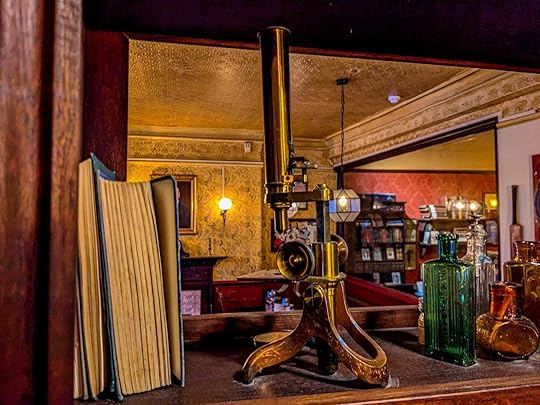
But no! The Sherlock Holmes opened way back in 1957, almost seventy years ago. It was a themed pub before themed pubs were even a thing.

Much of the collection on display is even older. It dates back to 1951 when the Marylebone Public Library decided to create a collection for the Festival of Britain.
But the pub isn’t only a collection of Holmes memorabilia. Patrons can also check out a recreation of Holmes’ sitting room at 221B Baker Street.
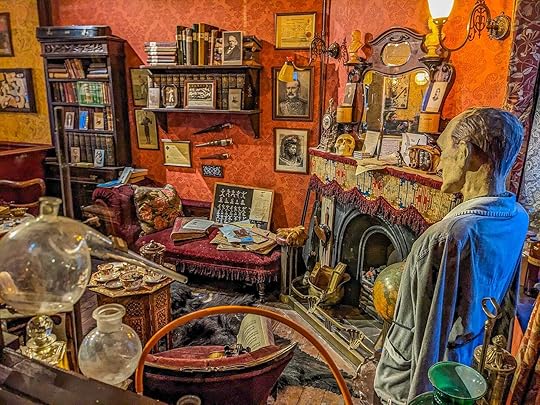
Since opening, the pub has been a draw for Holmes’ enthusiasts — including myself. As a boy, I loved watching classic Holmes movies, like The Hounds of the Baskervilles, starring Basil Rathbone.
But I also loved the new series on PBS a few years ago. How about you folks? Any Sherlock fans here?

Okay, everyone, time to go. I don’t know about you, but I’m feeling a wee bit tipsy. Be careful getting up!
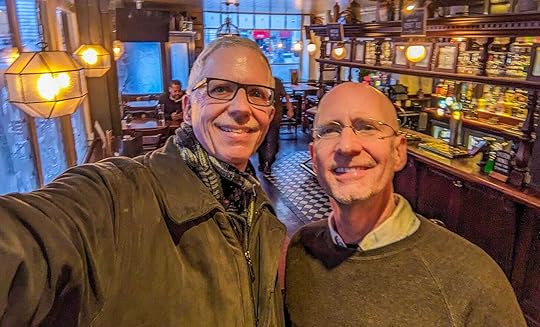 FLIGHT CLUB Bloomsbury
FLIGHT CLUB BloomsburyAddress: 6 Sir Simon Milton Sq, London

Okay, this place took more work to find than I thought. I guess three apple ciders have really gone to my head. Hoo boy!
Speaking of which, maybe we should’ve come to this pub first. Why?
Because Flight Club — a play on the movie Fight Club starring Brad Pitt — is a pub built around the very British game of darts!
So let’s everyone be careful of our aim, okay?
Let’s head inside.

Check out the gorgeous wallpaper. This place is class with a capital “C.” But don’t get distracted going down those stairs.
If you think the entry is gorgeous, wait until you see the bar right around the corner.

How fantastic is that? Inspired by a carousel, it’s a one-of-a-kind, and I’m pretty sure it’s gonna be one of the highlights of our pub crawl.
The Flight Club has a lot of classy touches, including these fun stained-glass windows.
The horse you see below is named “Andrea” and goes right along with the bar’s carousel theme.
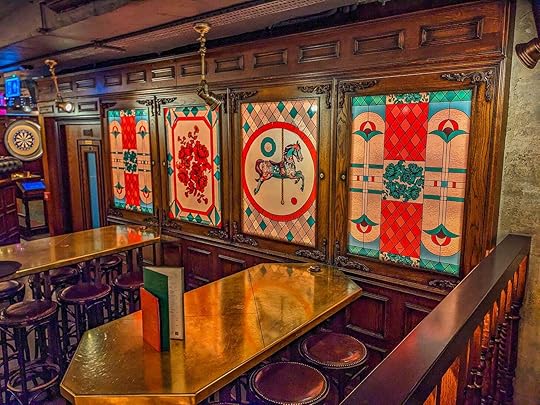
Why is this pub named Flight Club Bloomsbury?
Because the club is located in the Bloomsbury district in London’s West London, long considered a cultural, intellectual, and fashion center of London.
If you’ve heard the name Bloomsbury, it’s likely in association with “the Bloomsbury Set” — writers and thinkers such as Virginia Woolf, John Maynard Keynes, and E.M. Forster. I bet they used to get drunk and play darts here.
Speaking of which, grab a drink and play a game ourselves.

Check out this sweet setup. It has great wood paneling and that fantastic mural, and it has a high-tech scoreboard that electronically senses where your dart hits.
Here’s my first throw…

Oh, geez, sorry about that, Barb. Are you okay?
That doesn’t look like too much blood. Okay, yeah, it really was a bad idea coming here this late into our pub crawl.
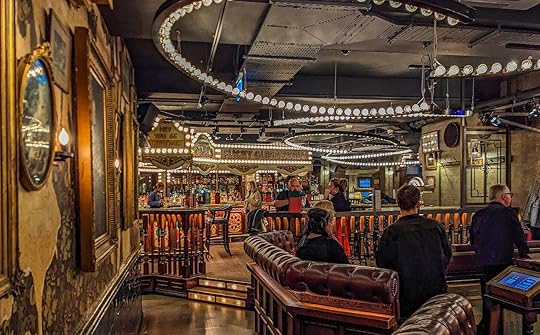
Why don’t we all finish up our drinks and head out before someone loses an eye? That’s four down and two to go!
MR. FOGG’S TAVERNAddress: 58 St Martin's Ln, London
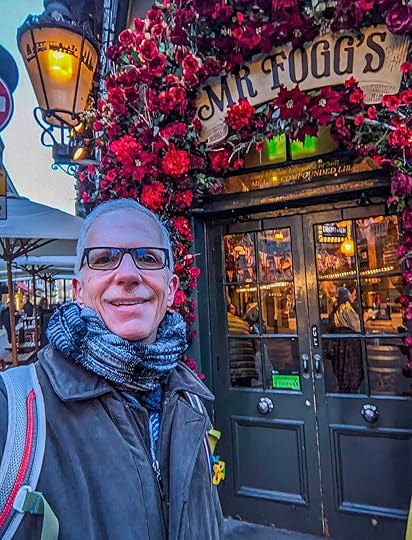
Is everyone here? Let me count. One, two, three, five, two…
Wow, those ciders are potent! Oh, well, it’s not like you guys signed releases.
Okay, so this is Mr. Fogg’s Tavern, and I fell in love with it the minute I walked by.

Take another look at the doorway!

As us Americans like to say, “Go home big!” No, wait, “Go big or go home!” That’s not it either. Got it!
“GO BIG OR GO HOME!”
Anyway, Mr. Fogg’s really went big. Let’s go inside and check it out. I hope we can get a seat. The first time I came here, it was absolutely jam-packed.
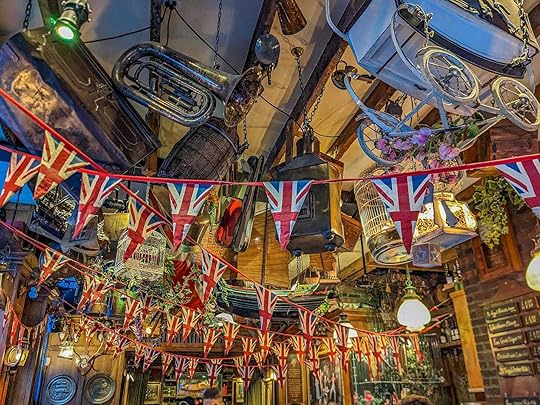
Look, there’s an empty table. Grab it!
What did I say about going big? Have you ever seen so many Union Jacks? And look at that ceiling! There’s a French horn! A pram! A birdcage! Why?
Why not!
There are also antique pots, a brass diving helmet, and taxidermy.
Crazy, huh?

This rounds on me, and then I’ll tell you a bit more about Mr. Frogs, er, Mr. Foggs.
This Victorian-style pub is inspired by Phileas Fogg, the fictional adventurer from the Jules Verne novel Around the World in 80 Days. Maybe all the stuff up on the ceiling are things would’ve Mr. Fogg picked up on his travels?
Unlike some of the spots we’ve been to today, Mr. Fogg’s really goes in on the old-fashioned English pub feeling, and I love that.
On Thursday evenings, the pub hosts Cockney sing-alongs. Those sound like a blast.
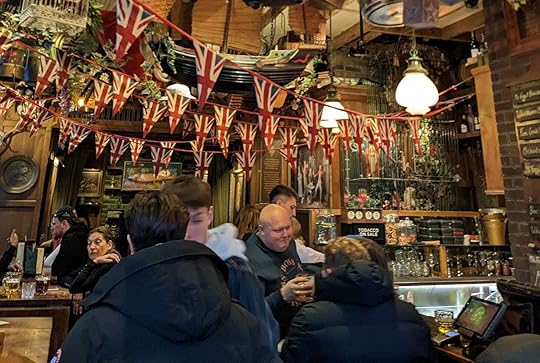
Did you notice the bartenders? They’re dressed up like we’re back in the 19th century, which would be totally awesome. Well, except for all the pollution from burning coal, the horse manure in the streets, women and minorities not having rights, and the whole Jack the Ripper thing.
But I digress.
On that note, it’s time for us to head off to our final destination. Grab your coats and I’ll meet you outside.

What’s that? Yes, I’m ready. I just wanted to take one last look because I like this place so much.
THE RABBIT HOLE PUBAddress: 151-153 Greyhound Lane, Streatham
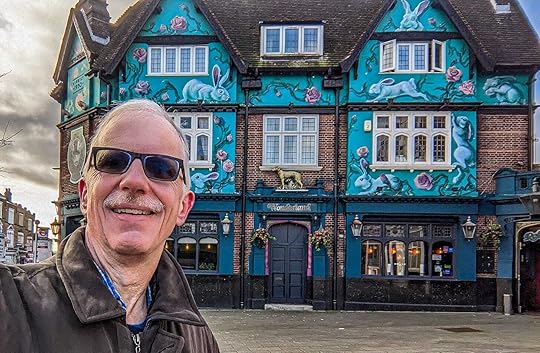
Are we ready for our last pub?
I saved it for last because it’s pretty trippy and I figured it would be good if showed up here…snoggered? Snookered?
Well, whatever they call drunk in Jolly Old England.
The first time I walked by the Rabbit Hole, I thought I was hallucinating. Was I really seeing a bunch of blue rabbits on that building?

Yup, I was.
Then I went inside — and things got more trippy.

How is that for a freaky mural? What vibe is this pub going for? Orange maniac? English LSD trip?
Because that mural freaks me the hell out.
Let’s go to the bar and get a drink, although given how bizarre this place is maybe that isn’t the best idea.
Oh, well! We’re almost done anyway.
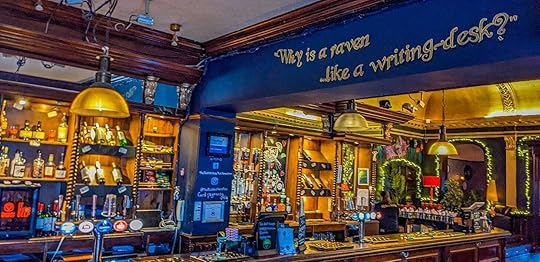
At least the bar looks relatively normal. Get your drink and take a look around and see if you can figure out what’s going on here.

Check out the blue little girl. And that bloody rose.
I told you this pub was trippy!
As you can see, the theme is Alice in Wonderland.
But not in a “let’s take the kids to the pub sort of way.”
It’s more like, “Let’s take some shrooms and see what happens” kind of way.
Let’s look more closely at Alice.

Her face is blue, but her hair is strawberry blonde. That’s unsettling. And is that really the face of a kid? She looks kind of hard to me as she spies on the Cheshire Cat, which is so far the most normal thing here.
The entire experience would be deeply unsettling if my head weren’t spinning from six pints of cider.
But the rest of the decor is quite classy. I could see hanging out here with a pint. Well, at least if they covered these murals.
Let’s pull up a chair and wrap things up.

What did everyone think? Aren’t London’s themed pubs pretty danged cool?
Awesome! I'm glad you enjoyed it. But again, Barb, I'm really sorry I hit you with that dart.
But at least it looks like the bleeding has finally stopped.
If you enjoyed this newsletter, I would appreciate your sharing it with someone you think might also like it.
Michael Jensen is a travel writer, amateur photographer, and novelist. Check out his other newsletter about his travels at BrentAndMichaelAreGoingPlaces.com.
October 23, 2024
I'm So Glad I Live in a World Where There are Octobers
“Oh, Marilla,” Anne exclaimed one Saturday morning, coming dancing in with her arms full of gorgeous boughs, “I’m so glad I live in a world where there are Octobers. It would be terrible if we just skipped from September to November, wouldn’t it?”
—Anne Shirley in “Anne of Green Gables”

Are you surprised I began this newsletter with a quote from Anne of Green Gables, the classic Canadian children’s book from 1908?
You shouldn’t be.
I might be a grown man, but Anne Shirley — the book’s main character — is one of my literary heroines, and this is one of my favorite quotes from her.
October is also my favorite month of the year — and not only because it’s the month I was born.
If I’d been born in July, I’d still love October.

Given that I’m from the U.S., for me, October is Halloween and grinning jack-’o-lanterns, and corn mazes, and hearty soups, and freshly picked apples, and apple ciders. And also harvest moons and harvest festivals, and piles of crunchy leaves, and the scent of wood smoke, and crisp autumn mornings when I can wear a thick jumper while enjoying the sunshine on my face.

Even the word “October” is lovely to look at. I love the plump jolliness of the two “Os” and the “b,” which looks like a fat, little tummy. Even the “c” has a pleasing round shape.
It’s as if the word itself has feasted on blackberries, apples, and acorns and is now ready for a long, cold winter.
But I especially love October because I’m a photographer, and all that fall foliage is out there waiting to be photographed.
Over the past seven years of nomading around the world, Brent and I have lived in places with spectacular Octobers: Kesztheley, Hungary, for example, and Helena, Montana.
But for me, one October has ruled them all: Prague in the Czech Republic.

Ironically, Brent had been the one most keen to visit Prague. Oh, I wanted to go, but not as badly as he did.
Then we arrived in October 2021, and I was gobsmacked. I knew instantly I’d never get my heart back.
Sure, Prague is widely renowned as one of Europe’s most beautiful cities.
I loved the spires and the red-tiled roofs. I was besotted from my first glimpses of Prague Castle, St. Vitus Cathedral, Old Town Square, and so much more.

This was a city I couldn’t wait to explore.
I have an idea! Why don’t you join me on one of my morning walks? But this isn’t just any walk. Today I want to find the perfect picture of Prague in October.
It’s a little after 6 AM as we leave the apartment. It’s chilly outside, in the 30s Fahrenheit, perfect for fog to form on the Vltava River, which is famous for its fog-shrouded mornings.
We’ll have to walk fast to reach the far side of the Charles Bridge before the sun rises and the mist burns off.
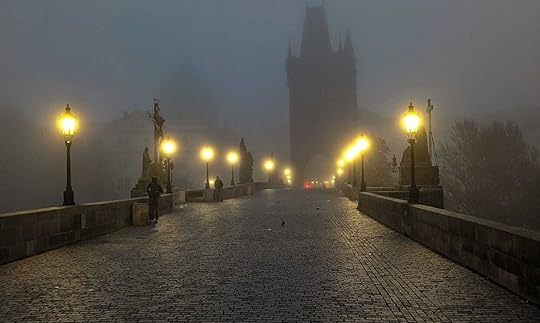
We made it! Now to watch the sun come up.
Here it comes.
It’s as gorgeous as I hoped. What do you think?

As the mist clears, I take picture after picture, trying to capture the city seeming to materialize out of nothingness. It feels like a little bit of magic.
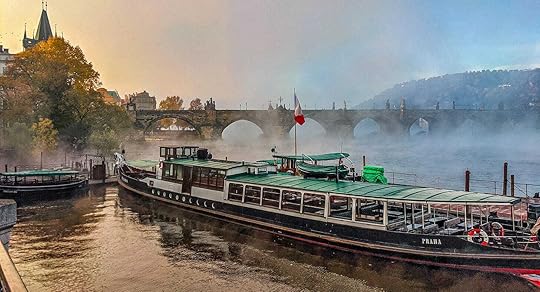
Eventually, the mist is gone entirely, and Prague reveals itself clad in scarlet scarves and burnished amber cloaks.
Is this my perfect picture?
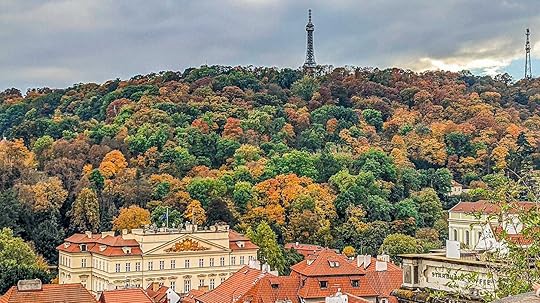
I marvel at how the golds, reds, and ambers go perfectly with the Bohemian sandstone used to build many of Prague’s bridges. The stone’s warm yellow color perfectly complements the brightly colored trees.

Let’s continue, shall we?
Walking along the Vltava, I feel perfectly happy — I hope you do too. How could we not on such a crisp fall morning with the trees in such perfect autumn colors?

I think a Czech saying about autumn captures what Prague feels like this morning: “Podzim je malíř, co hraje se zlatou a červenou.”
It means: Autumn is a painter who plays with gold and red. Marvelous, isn’t it?
I hope my perfect picture will live up to that saying.

A smaller bridge beckons. Let’s take a detour.
The mist is gone now, and a bright blue sky is overhead. A small canal filled with still water catches the trees’ reflections.

Farther on, a small stone bridge crosses another canal. A garland of magenta-colored leaves drips from the bridge, and I hear Anne Shirley’s voice saying, “Dear old world, you are very lovely, and I am glad to be alive in you.”
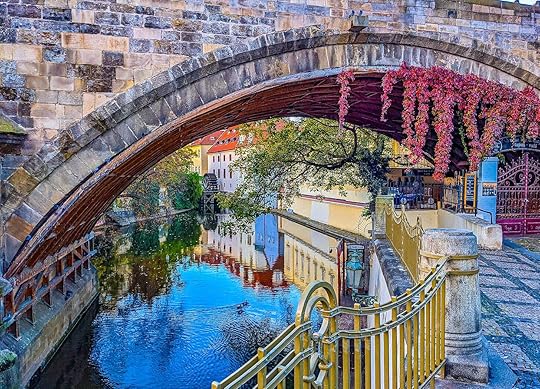
Flaming ropes of ivy are everywhere — tumbling from fences, draped on walls, and clinging to gates.
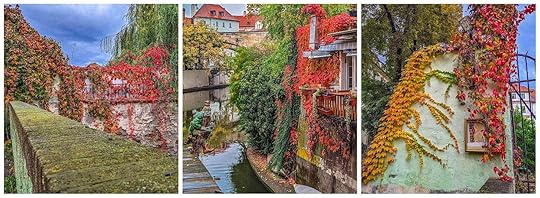
Prague’s parks are equally stunning.
Let’s head for one of the most beautiful — Grébovka Park.
This Italian Renaissance-style park was built in the late 19th century on land that had been vineyards for centuries. And some of the vineyards are still there.

Grébovka is only minutes from our apartment, so Brent and I walk here almost every day.
We love the sloping hills and the kids playing in the leaves — and especially — the October sun using its alchemy to turn the leaves to gold.
I hope you revel in it as much as we do.
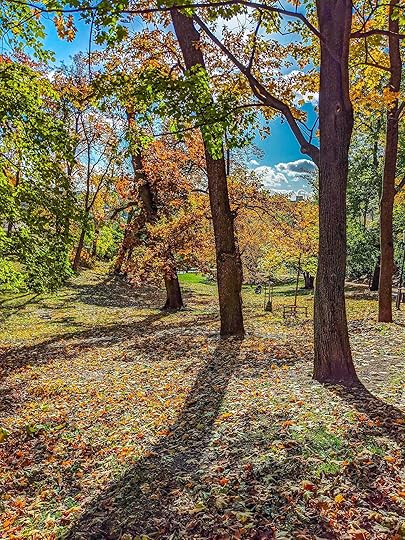
Did you know the light in October truly is different from the rest of the year?
The sun hangs lower in the sky, the angle of the light creating softer, golden-tinged tones. Science tells us the wavelength of this light enhances reds, oranges, and yellows.
I dislike thinking of such a lovely part of nature in such prosaic terms. I’d rather sit and soak it in.

The park is filled with trees and the green grass is already covered with a thick carpet of leaves.
Oh! I want to show you a little pond tucked into a nook. Isn’t it pretty?

I love the sound of the leaves crunching crisply under my feet and the dry, earthy smell that reaches my nose.
Lampposts dot the park, and every time I see one, I pretend that I’m in Narnia and Mr. Tumnus will emerge from the woods at any moment.

He never does, but that’s okay. Enchanted faun or not, I’m still surrounded by the magic of trees in autumn.

The sun is lower in the sky now; the shadows of the trees stretch out as if trying to keep the sun from leaving.
I feel that way, too: sad that the end of our day is drawing closer. And I still haven’t found my perfect picture.

Then I think of something else Anne Shirley said: “I believe the nicest and sweetest days are not those on which anything very splendid or wonderful or exciting happens but just those that bring simple little pleasures, following one another softly, like pearls slipping off a string.”
She’s right, I know, but I confess, I’d still like to find that perfect picture.
The light is waning now and will soon be gone. There’s one more place I want to take you before we both go home.

It’s Olšany Cemetery, one of several remarkable graveyards in Prague.
Maybe I’ll find my perfect picture here.

Olšany is the largest cemetery in Prague, almost four hundred years old. Trees watch over simple graves, art nouveau tombs, and silent crypts.
A carpet of leaves covers almost everything, yet nearly all the trees are still cloaked in autumn colors.
It’s like we’ve fallen into a fairy tale — perhaps a slightly scary one.

Walking up and down the tree-lined rows, autumn here feels even more poignant than past October walks.
Perhaps it’s that I’m in the “autumn” of my own life. I just had another birthday, and I know there are now fewer October ahead of me than behind.

This is when I realize something: the point of our walk wasn’t to find the “one” perfect picture — because, of course, no such thing exists.
Instead, the point is to enjoy this one October day in oh-so-lovely Prague — and for all of us to realize how lucky we are to live in a world of Octobers.
If you enjoyed this newsletter, please share it with someone you think might also like it. I appreciate your help spreading the word about my work! And while Michael Takes Too Many Pictures is a free publication, feel free to help support my work by clicking the “Buy Me a Coffee” button below. Grazie!
Michael Jensen is a travel writer, amateur photographer, and novelist. Check out his other newsletter about his travels at BrentAndMichaelAreGoingPlaces.com.
October 21, 2024
Varoš: The Tiny Croatian Neighborhood That Taught Me A Big Lesson
This post originally appeared on Brent and Michael Are Going Places.
Brent and I are “slomads” — digital nomads who practice “slow travel.” We stay in most of our destinations anywhere from one to three months. And because of that, I pride myself on the fact that I get to know the places we stay more deeply than tourists who can’t stay that long.
But life has a way of humbling you.
In our current home of Split, Croatia, I was recently whining to a fellow nomad how after two months, I was bored. “Split is so small, and I’ve seen everything there is to see!” I said.
“Can I see some of your pictures?” she asked.
“Of course,” I said, always happy to show off my photos.
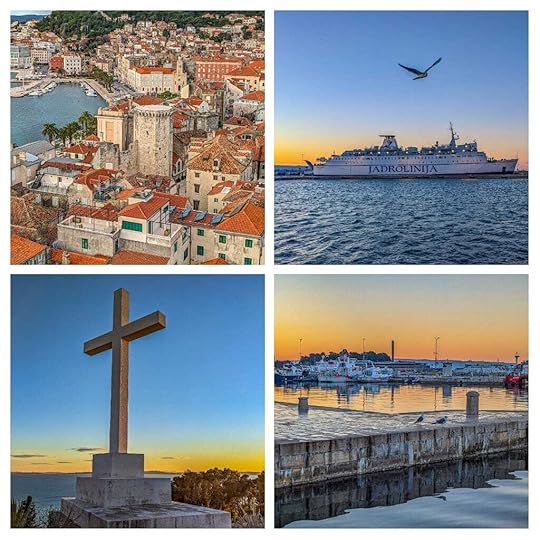
“Very nice,” she said. “I see you’ve got all the ‘big’ things.”
I could tell by big, she meant obvious.
“Is there something I missed?” I asked.
“Have you seen Varoš?”
“What’s that?” I said, confused.
“It’s a neighborhood,” she explained. “It’s not especially famous, but I still think it’s very special. And I’m surprised you’ve missed it, since you practically live right on top of it.”
“I guess I need to check it out,” I said, feeling chagrinned.
After she left, I did a Google search and found that, sure enough, Brent and I did live right near Varoš. I’d walked right by the entrance to this ancient neighborhood every single day.
The following morning, camera in hand, I took it upon myself to explore the neighborhood — which dates back to at least the 15th century, when it was first officially mentioned in religious records.
I quickly discovered that while this neighborhood of tiny, twisty streets didn’t contain any obvious wonders — like the 3,500 year old sphinxes in nearby Diocletian’s Palace or the sweeping vistas from the top of Marjan Hill — it definitely had its own charms.
And maybe little wonders. You just had to look a bit more closely to see them.
 One of my favorite discoveries! The reflection in a window of a mural on the other side of the street.
One of my favorite discoveries! The reflection in a window of a mural on the other side of the street.Just how narrow are the labyrinthine streets? In some places, it’s possible to stick out your arms and touch either side.
Naturally, there are no cars — although there are specially designed one-person garbage trucks able to make their rounds picking up trash.

Wandering through the neighborhood, I couldn’t help but marvel at the tiny stone houses. Brent and I had spent much of the past four years in Europe — famous for its small dwellings.
But nothing quite matched what I was finding in Varoš.
 A typical stone house in Varoš.
A typical stone house in Varoš.Determined to not repeat my past mistake of missing the forest for the trees, I explored Varoš slowly, paying close attention to my surroundings.
And sure enough, I immediately began noticing things.
Like this Santa Claus perched up on the wall long after Christmas.
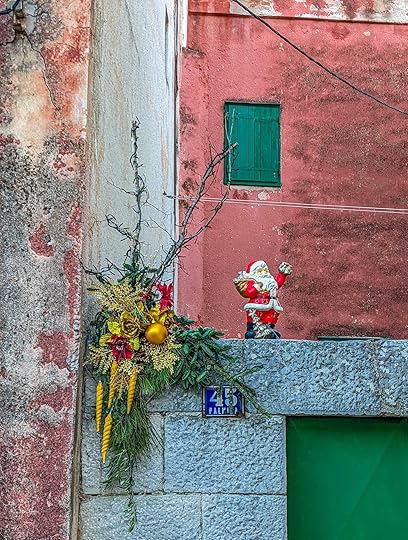
Or this cat keeping watch on passers-by.

I’d read that despite it’s small size, Varoš was home to several churches, including the Church of St. Nikola (Mikule), which historians believe was first built in 1056 CE.
But Varoš is a warren of dead-ends where narrow lanes end in courtyards or abandoned buildings.
Try as I might, I couldn’t find the church.
 This house appeared to be filled with the rubble of a collapsed roof.
This house appeared to be filled with the rubble of a collapsed roof.Then I spotted a nun. Nun = church, right?
Maybe!
I followed her.
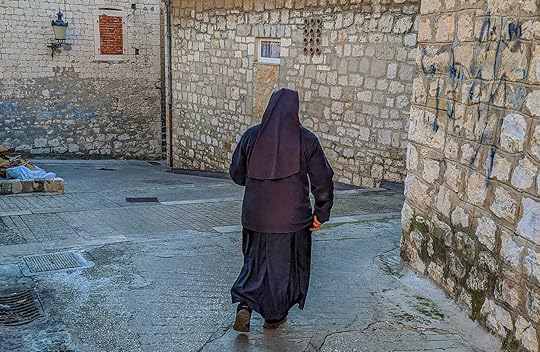
And, before long, she led me right to the Church of St. Nikola!
Though — ironically — it wasn’t her destination, and she kept walking right on by.
Unfortunately, the door to the church was solidly locked.
But so early in the morning, I had the area to myself and could snap pictures to my heart’s content.
 Success! The Church of St. Nikola is almost one thousand years old.
Success! The Church of St. Nikola is almost one thousand years old.Varoš grew up around the Church of St. Nikola, a neighborhood of poor fishermen, farmers, and peasants who built small stone houses for their families.
The neighborhood used to be considerably bigger, but much of it was razed in the 17th century to build ramparts to defend against invasion by Turks from the powerful Ottoman Empire.
That made me wonder what those long-ago vanished streets had looked like.
 The Varoš neighborhood climbs up the eastern end of Marjan Hill.
The Varoš neighborhood climbs up the eastern end of Marjan Hill.During the 18th, 19th, and 20th centuries, Varos steadily declined. Many residents departed for “better” neighborhoods, leaving behind empty buildings that slowly fell into disrepair.
Those who stayed struggled to maintain their homes, much less modernize them.

But ten years ago, things started to change again. Varoš was rediscovered by wealthy Croats — and even more wealthy Europeans from other countries.
They started buying and repairing the dilapidated structures, turning them into modern apartments and boutique hotels. I met an architect at the local coworking facility, and she showed me a fantastic conversation she had recently finished.

Here’s the architect, Helena Miler:
 The renovated apartment is on the top floor of the building to the right.
The renovated apartment is on the top floor of the building to the right.All this made me happy for the people of Varoš — and Split. After all, what good is blight to anyone?
Of course, the transformation of Varoš is not yet complete. Plenty of elegant decay remains.

And I was glad to see it. Isn’t there beauty in imperfection too?
Or maybe I only feel that way because my own imperfections had almost caused me to miss the hidden gem called Varoš.
Hopefully I’ve learned my lesson, and I won’t miss what is right underneath my nose ever again.
Michael Jensen is a travel writer, amateur photographer, and novelist. Check out his other newsletter about his travels at BrentAndMichaelAreGoingPlaces.com.
The Touching Lesson Behind Istanbul's Love for Its Many — MANY — Cats
This post originally appeared on Brent and Michael Are Going Places.
For Brent’s thirtieth birthday, I surprised him with two kittens — despite the fact that we were living in a tiny, one-bedroom apartment at the time.
On one hand, Brent — the walking embodiment of a cat lover — adored the kittens.
On the other much more annoyed hand, he wanted to kill me for springing such an impractical surprise on him.
In the end, it worked out, and life without Hugh and Thibodeau, as we named them, is now unimaginable.
But many years later, when both cats had died, we decided not to replace them, because we hoped to do some extended travel at some point.
Little did we know we would soon become digital nomads and leave the U.S. for a life of indefinite travel.
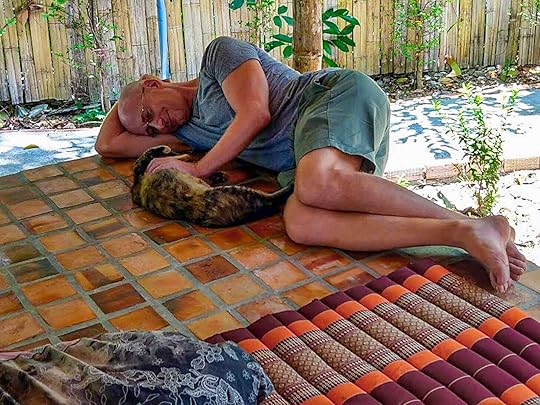 Brent with a new feline friend in Thailand
Brent with a new feline friend in ThailandThere haven’t been many things we’ve missed from our old lives, except seeing friends and family on a more regular basis.
And having cats in our lives.
Especially Brent, who had never met a stray cat that was too scraggly, flea-bitten, and possibly rabid that he didn’t want to stop and pet it.
I’m serious about that. I have literally intervened and told him not to touch certain very scary-looking animals. Sad, but scary-looking.
Thankfully, there are cats all over the world, and I think Brent has now petted and cuddled at least ten percent of them.
So when we recently moved to Istanbul and saw stray cats everywhere, Brent was ecstatic.

In fact, the city is famous for its many — many! — stray cats. They’re literally everywhere, peering down from fence posts and lounging on steps.
People do keep cats as pets, but the ones you see outdoors are almost invariably strays.
And the most beautiful thing in this magical city may be the locals’ unique relationship with these felines. We’ve never seen anything quite like it.
 A typical sight on the streets of Istanbul
A typical sight on the streets of IstanbulOn one hand, the Istanbullular — the fantastic word for people who live in Istanbul — clearly love these animals. Throughout the city, they leave out bowls of water and containers of food. Or they simply put out scraps of food, often from their own meals.
They also build “cat houses,” which are everywhere: in parks, alleys, vacant lots, and tucked under stairwells. Some are simple affairs, plastic containers or cardboard boxes.
But others are very elaborate, constructed of wood. We’ve seen entire cat condominiums, which the cats love, because it gives them a place to sleep and also a vantage point from which to view the passing world.
 Houses for stray cats range from simple cardboard boxes to plastic containers to fancier ones built out of wood.
Houses for stray cats range from simple cardboard boxes to plastic containers to fancier ones built out of wood.In fact, cats are given almost complete free reign in this city of fifteen million humans. They go wherever they want, flopping down in the middle of sidewalks and plazas where people have learned to simply step around them.
Cats are also allowed inside buildings, even cafés and restaurants, where they often occupy chairs — and once again, no one dares disturb them. In stores, the unwritten rule is that you never disturb a cat, even if it’s sitting on the merchandise!
Once we even saw a rug merchant place a tiny rug over a sleeping cat. (Naturally, I whipped out my camera and snapped a photo.)
 Even though this stray belongs to no one, everyone helps take care of it.
Even though this stray belongs to no one, everyone helps take care of it.They even wander into mosques in the middle of prayers.
The Turkish government and local community groups also work to vaccinate, neuter, and spay these stray cats.
This all seems oddly selfless on the part of the Turks. After all, these aren’t cats that will purr in your lap or curl up in bed with you.
Yes, occasionally, you’ll see a Turk stop to pet a stray cat — though tourists are far more likely to do such a thing. And, yes, if you’re sitting on a bench, a cat might approach, purring as it wends its way between your legs.
 Just one of the many many many cats Brent has petted here in Istanbul.
Just one of the many many many cats Brent has petted here in Istanbul.But for the most part, humans do all these things for the cats, and the animals largely ignore them. Or sit and judge them in that uniquely feline way.
This couldn’t seem more different than the relationship Americans have with their pets.
In America, we have Dog Dads and Cat Moms. People consider cats and dogs to be members of their families. They buy them treats and Christmas gifts, talk to them, and constantly lavish attention and affection.
And in exchange, Americans expect companionship and affection back from their charges, if not slavish devotion.
The relationship is undeniably quid pro quo: you follow my rules, adore me — or at least purr on my lap — and I’ll keep taking care of you.
So why such selfless behavior on the part of the Istanbullular?
It began as a question of religion.
Islam places a high value on cleanliness.
Cats are understandably admired for being very clean animals — even “ritually clean,” as outlined in the Quran. Muhammad, the founder of Islam, was said to be very fond of cats. In fact, according to one story, he cut off the sleeve of his shirt rather than disturb the cat sleeping on it.
 One morning it was just me and a cat in Istanbul’s famous and fabulous Hagia Sophia mosque — but, of course, the cat was indifferent.
One morning it was just me and a cat in Istanbul’s famous and fabulous Hagia Sophia mosque — but, of course, the cat was indifferent.Islam also commands that people treat all living creatures with respect. (We’d argue that many Muslims, like many Christians, should treat LGBTQ people with more respect. But that’s the subject of another column.)
But the relationship between the Istanbullar and these cats seems like it’s based on more than just religious obligation. It feels as much about kindness, and decency, and doing the right thing simply because it is the right thing to do.
That’s part of what makes it so beautiful.
What of Istanbul’s stray dogs? In fact, in Islam dogs are considered dirty — perhaps accurately, at least compared to cats — and possibly even “impure.”
But because of Islam’s teachings, the city still takes good care of its some hundred thousand stray canines.
 Istanbul’s stray dogs are taken care of but are shown little affection.
Istanbul’s stray dogs are taken care of but are shown little affection.Dogs definitely aren’t allowed inside cafes, shops, or mosques — perish the thought! — and no one ever builds houses for them. But they’re given medical care and even shelter when it’s especially cold. People also provide them with plenty of scraps to eat.
The truth is, the dogs all seem kind of sad, glumly sleeping their lonely lives away in the parks and alleys, as if they recognize their obviously inferior status compared to the city’s cats. But at least they’re rarely abused.
We’re visitors here in Turkey, and as in all the places we travel, we try to reserve judgment as much as possible, trying to understand local customs and meet people where they are.
But we absolutely see a great beauty in the relationship between Istanbullular and their cats.
Most of us could probably stand to be more selfless like this.
Michael Jensen is a travel writer, amateur photographer, and novelist. Check out his other newsletter about his travels at BrentAndMichaelAreGoingPlaces.com.
October 14, 2024
My Lifetime Love Affair with Sydney's Amazing Rock Pool

This post originally appeared on Brent and Michael Are Going Places.
For the audio version of this article, read by the author, go here.
Back in 1982, I was a high school exchange student in Cronulla, Australia. As a kid from Colorado, I had only seen the ocean once before, and I was dazzled by the waves breaking against the rocky shore.
But one thing didn’t make sense. It looked like there was a swimming pool right on the beach. It was filled with water and seemed to blend right into the shore itself. Was it full of seawater?
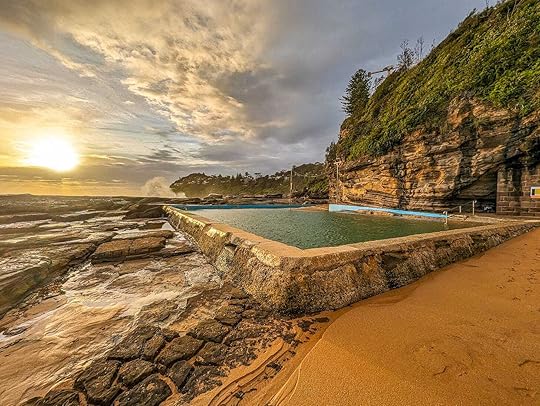 Just one of Sydney’s many rock pools.
Just one of Sydney’s many rock pools. I asked Phil, the father of the family who was hosting me, what it was.
“That’s the Shelly Beach rock pool,” he explained. “It’s full of saltwater from the ocean. People swim in it.”
“But the ocean is right there,” I said. “Why do they need a pool at all?”
“The surf gets pretty big here. Plus there are dangerous currents called rips. A rock pool protects you from all of that. Anyway, it’s an Australian thing. I bet you’ll like swimming in them.”
Phil turned out to be more right than he knew. For a teenager who had grown up in landlocked Colorado, I couldn’t get enough of that pool.
It also began a lifelong obsession of mine with Australia’s rock pools — also known as “ocean pools,” or sometimes “baths.”
Last year, I returned to Australia for the fourth time, finally bringing Brent. And just like on my previous three visits, I spent hours swimming in the rock pools.
And this time, I also took pictures.
 The actual Shelly Beach Rock Pool, where I spent many a morning.
The actual Shelly Beach Rock Pool, where I spent many a morning.Why am I — along with much of Australia — so crazy about rock pools?
For one thing, no two rock pools are the same. That’s largely because each location is unique, and each rock pool really is built to conform to its surroundings, literally blending into the coast, whether it be a rocky headland or a sandy beach.
Some rock pools are barely more than simple concrete walls arranged into three sections enclosing part of the sea, while others are hewn directly out of large shelfs of rocks jutting out into the ocean. Meanwhile, others are so well-developed and elaborate they look essentially like a proper swimming pool.
 Bondi Beach’s iconic rock pool and a much simpler one in Cronulla.
Bondi Beach’s iconic rock pool and a much simpler one in Cronulla. Elaborate or simple, almost all rock pools offer fantastic ocean views — as well as a refreshing place from which to take in that view. And they’re often built on sections of the coast that are, well, rocky, which adds to the scenic beauty.
As Phil told me all those years ago, rock pools really do protect swimmers from treacherous surf and currents. At the same time, they let everyone — kids and older folks alike — smell, taste, and feel that lively sea.
And they really are replenished by water directly from the ocean — at high tide, of course. Most rock pools have sandy bottoms, and you might even spot fish swimming inside — temporarily trapped, not unlike a natural tidepool.
And yes, the occasional shark has also landed inside a rock pool.
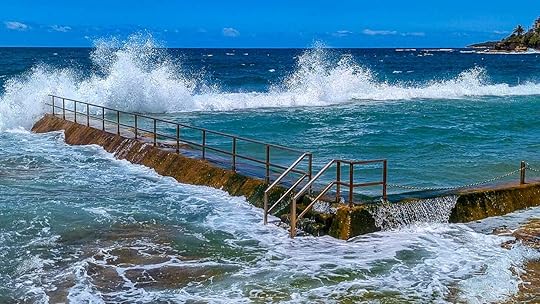
But for the most part, swimmers get a sense of what it’s like to swim in the open sea — without worrying about sharks or riptides.
I’ve spent a lot of my time in Australia in Sydney, which faces east. This means rock pools are especially magical here at dawn, the sunrise lighting up the sky and water with streaks of orange and red and purple. Think of it as nature’s lightshow.
During Brent’s and my three weeks at Whale Beach in northern Sydney, my absolute favorite thing was to go for a swim at dawn. Many mornings I had the place entirely to myself, only a few seagulls sharing the tranquility with me.
Brent mostly slept through my early morning swims, although he did occasionally join me for my return visits in the afternoons.
I really am obsessed with rock pools.
 Whale Beach in the morning was my happy place.
Whale Beach in the morning was my happy place. Some mornings, the sea was almost completely calm as it reflected the rising sun. Other times, huge waves dashed themselves against the rocks just beyond me.
One morning, the tide was so high and the surf so strong that waves broke over the side of the pool and kept crashing down on my head. Over and over again, I gasped in surprise, my ears filled with the buzzy fizz of the water churning around me.
But I always swam on undaunted.
Many rock pools have a heavy raised chain around the sides of the pool to keep swimmers from being washed out when the waves are too high or rough. One of my favorite memories from my time as an exchange student was when a group of us teenagers ventured into a rock pool during a high tide coinciding with a very big surf.
That day, massive waves spilled over the outer rock wall, sending water rushing across the interior of the pool. But we were determined to reach the chain on that far wall, and eventually, we did.
Then we clung to that chain while waves crashed around and even over us. We held fast, until a wave clobbered us so hard that we’d lose our grip and the water carried us back toward the shallow end of the pool. Then we’d repeat the whole process again.
Of course, we laughed all the while.
 Like this, but bigger. Much bigger!
Like this, but bigger. Much bigger!Rock pools have a long and storied history in Sydney, as well as the entire state of New South Wales. Sydney itself has nearly three dozen pools. The whole state is home to over a hundred.
While you can find the occasional rock pool in various places around the world, only Cape Town, South Africa, has a sizable number — nineteen total. That’s because like Sydney, Cape Town’s beaches have dangerous rips, sharks, and a rocky coast.
Australia’s first rock pool was built in Newcastle, NSW, back in the 1820s. Convicts using pickaxes widened the natural opening already there so soldiers could safely swim in what became known as Bogey Hole.
Was this the world’s first rock pool? That might depend on how you define “rock pool.”
 Picture, left: Bogey Hole, date unknown. Source. Picture, right: Bogey Hole at high tide, 2011: Source: Leighblackall
Picture, left: Bogey Hole, date unknown. Source. Picture, right: Bogey Hole at high tide, 2011: Source: LeighblackallRock pools initially became popular in Australia in the late 1800s, because at that point, public swimming during the day was illegal. However, private “baths” were allowed, so rock pools became an ingenious way to create a spot to safely and legally swim.
Swimming suits weren’t yet popular, so people often swam nude, in segregated locations.
By the 1920s, mores had loosened and swimming became more popular, especially with the advent of swimming “costumes.” But Sydney’s rocky coast remained a genuinely dangerous place, due to, yes, rough surf, powerful rips, and those pesky sharks.
So rock pools remained popular, and even more were built during the Great Depression thanks to a government works plan designed to give people jobs.
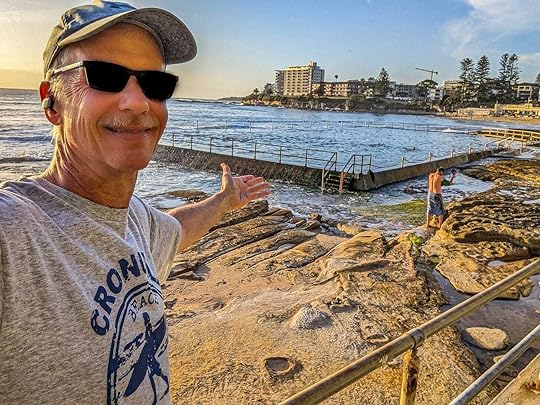 Wearing a Cronulla t-shirt while visiting one of Cronulla’s rock pools.
Wearing a Cronulla t-shirt while visiting one of Cronulla’s rock pools. Rock pools also served as a way for Surf Clubs — community-based organizations dedicated to water safety — to train lifeguards.
Today rock pools often serve another community function: as homes to unofficial swimming clubs, as I discovered one chilly morning while out walking in Cronulla. I’d gone down to the Shelly Beach rock pool to snap some photos when I noticed a small yellow building with a sign reading “Home of the Brass Monkeys.”
How the heck have I never noticed this building before? I wondered. And what’s a “brass monkey”?
I struck up a conversation with a couple of folks there who had just gotten out of the nearby rock pool. (Talking to strangers is something I do a lot.)
 Owen and Angela, not long after Owen finished his morning swim.
Owen and Angela, not long after Owen finished his morning swim. Owen and Angela, seen above, told me the Brass Monkeys was the unofficial swim club for the Shelly Beach rock pool. To become a member, you had to swim in the pool every day for a year.
Owen, who was the swimmer in the family, told me, “The water gets awfully cold here in winter. So you have to be pretty tough to make it.”
I finally remembered the saying, Cold enough to freeze the balls off a brass monkey. Now I understood the group’s name, and it made me smile.
They showed me a sign dedicated to a now-deceased member who had swum in the rock pool almost every day for nearly fifty years.
“You should have a go yourself,” Owen said. “It’ll wake you up.”
Since no part of me is made of brass, I laughed and said, “It’s too cold today for this wimpy American.” Then I walked on.
I may not be as intrepid as the Brass Monkeys, but I’ve loved Australia’s rock pools my whole life, and as I write this article, I find myself asking why.
In the end, I think it’s because rock pools are a kind of nexus point, a magical spot where the safety of the land meets the danger and mystery of the ocean.
Plus, they’re just so incredibly fun.
Michael Jensen is a travel writer, amateur photographer, and novelist. Check out his other newsletter about his travels at BrentAndMichaelAreGoingPlaces.com.
June 19, 2023
I'm Michael. I Write Gay Historical Fiction.
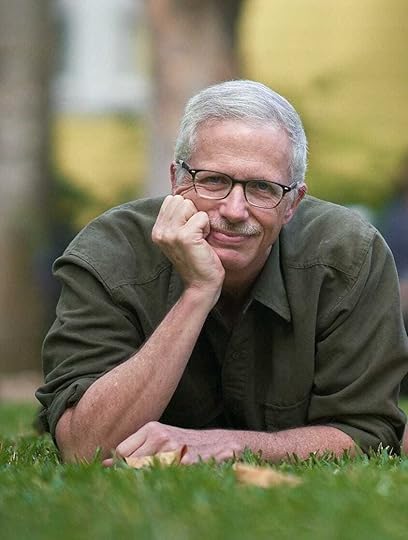
I'm Michael Jensen, an author, editor, and world traveler. My books of gay historical fiction include The Savage Land series, which takes place on the American frontier. The first book in the series is Man & Beast, and the second book, Man & Monster, was a Lambda Award Finalist (under the title Firelands).
I'm currently at work on several other series of gay historical fiction.
Thanks for reading! Subscribe for free to receive new posts and support my work.
I'm also the co-founder of AfterElton.com, which covered pop culture for gay and bisexual men, and eventually became one of the largest and most influential LGBT websites on the internet. In 2006, AfterElton.com was sold to MTV/Viacom in a multimillion dollar deal. As editor until 2010, I interviewed hundreds of writers, directors, and actors, breaking numerous stories and advancing the issue of LGBT visibility in Hollywood.
To get updates on my writing career, subscribe here:
Subscribed
In addition to my writing career, I've always loved to travel. In my twenties I lived and worked in Australia, backpacking around the country, as well as popping over to do some trekking in New Zealand. Over the years my husband, writer Brent Hartinger, and I took various trips, but we always dreamed of living overseas.
 Me at Angkor Wat in Cambodia.
Me at Angkor Wat in Cambodia.We're pretty sure we would've left America eventually, but the election of Donald Trump made it happen sooner rather than later. We soon sold our house, got rid of most of our possessions, moved our life into the cloud, and became digital nomads.
Here are all the places we’ve lived for at least a month:
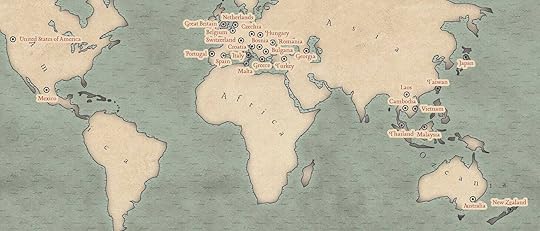
You can follow our "digital nomad" journey by subscribing to that newsletter too. Somehow it’s become weirdly popular. Who knew?
But to just get updates on my books and writing career, subscribe here:
Subscribed
You can also contact me via email, Facebook, Twitter, Instagram, or you can connect with me through Goodreads.
Michael
Thanks for reading! Subscribe for free to receive new posts and support my work.
June 10, 2023
Sleeping With the Enemy: My Struggle with Insomnia
For the audio version of this article, go here.
 Photo by Annie Spratt on Unsplash
Photo by Annie Spratt on UnsplashI’ve lived with insomnia for more than twenty-five years, which is most of my adult life.
I don’t mean the sort of insomnia where you have a sleepless night or two. I’m talking night after night of laying awake until two, three, or even four in the morning, utterly exhausted but unable to fall asleep.
It isn’t pretty. Sometimes it’s downright hellish.
How did I end up in this situation?
I blame it, in large part, on my twenty years working as a flight attendant. I had time-zone changes, early morning check-ins, and plenty of red-eye flights where my eyes were, in fact, pretty damned red.
The worst part was my five years of being “on reserve,” or on-call. My phone could ring at any time of night or day, and I would have to be at the airport in an hour or less.
And, of course, since it was day or night, I was constantly being woken up. It made it hard to ever truly relax. Was this the point where I lost the ability to sleep deeply?
It doesn’t help that my mind frequently races at night. I might plan my work for the next day, or fret over some real or imagined problem. Sometimes both.
Whatever the exact reason, by my mid-thirties, chronic insomnia was woven into the daily fabric of my life.
Upon hearing this, many people suggest treatments that have worked for them, which I appreciate.
But over the years, I’ve almost certainly already tried it.
I’ve limited my caffeine and alcohol consumption, gotten plenty of exercise, tried to perfect my “sleep hygiene,” kept a sleep-diary, and done most of the other common sleep strategies.
I’ve tried acupuncture, hypnosis, meditation, and a number of different white noise machines.
I’ve consulted with multiple doctors and participated in two sleep studies that turned up nothing helpful.
I’ve had a half-dozen sessions with a sleep therapist.
I saw a psychiatrist for several months, trying various kinds of cognitive behavioral therapy.
I did two rounds of intensive sleep restriction therapy, which basically turned months of my life into even more of a living hell.
Need travel or international health insurance? We recommend Genki or Safety Wing. For a travel credit card, get 60,000 free miles with Chase Sapphire Preferred. Using these links costs you nothing and helps support our newsletter.
Here are the prescription, over-the-counter, and natural medications I have tried: Ambien, Sonata, Lexapro, Paxil, Seroquel, Atarax, Xanax, Trazodone, Nortriptyline, Doxepin, Diphenhydramine and Doxylamine (antihistamines), and various combinations of melatonin, valerian root, chamomile, and other natural sleep aids.
No over-the-counter medication or natural treatment has ever worked for me, at least not long-term.
Only one prescription medication has consistently worked: Xanax.
 Photo by Myriam Zilles on Unsplash
Photo by Myriam Zilles on UnsplashUnfortunately, due to addiction and other issues, Xanax isn’t a long-term solution, and my doctor severely limits the amount he will prescribe.
In the early years of my insomnia, I eagerly tried all these different therapies and medications, certain there was a solution out there for me.
Surely, I thought, something will work.
But one by one, each medication or treatment either:
Failed me outright (hypnosis, noise machines).
Had some serious complications (hello, Ambien hallucinations!).
Or eventually stopped working, no matter how high the dosage (Trazodone, which caused shockingly severe withdrawal problems).
As treatment after treatment failed, I moved through different stages of dealing with the problem. Optimism gave way to anger. Sometimes I became utterly enraged. If insomnia had been a living thing, I would have gladly and viciously strangled it with my bare hands.
One night, after tossing and turning for hours, I stormed out of our bedroom, stomping around the house swearing a blue streak.
If Brent hadn’t been awake before, he was now. It isn’t only the insomniac who has to deal with the repercussions of insomnia.
Soon, I reached a really low point. Entering our bedroom felt like stepping onto a battlefield. And getting into bed literally felt like sleeping with the enemy — or at least trying to.
 Photo by Chuanchai Pundej on Unsplash
Photo by Chuanchai Pundej on UnsplashAnger gave way to other equally dark emotions: despair and pessimism. It fell to Brent to keep encouraging me to try different solutions. I tried them all, but you already know how that turned out.
More than once, I told my worried husband I wasn’t sure how long I could live this way.
I wasn’t kidding.
One of the ironies of my insomnia is that after some of my worst nights, I can actually feel fine for much of the next day. And some of my better nights are followed by feeling utterly exhausted.
Even my good days almost always involve what I call the Wall of Exhaustion. That’s when my sleep-deprived mind and body become overwhelmed by tiredness and I have no choice but to go lie down.
Brent and Michael Are Going Places is reader-supported. To receive new posts and support our work, consider becoming a free or paid subscriber.
Subscribed
For a long time, I tried to figure out how I could barely sleep at night, yet feel okay on some of the days after.
If only I can pin down the reason, I told myself, I’ll have my solution!
But the solution to the puzzle never came.
At some point, I realized I’ll probably never be rid of my insomnia entirely — and maybe never even change it all that much.
But there was one thing that could change: my attitude toward it.

I’m not a higher being — this didn’t come to me in a vision or a flash of insight. It wasn’t really even conscious.
One day, I simply realized I wasn’t feeling anger or despair about my condition anymore. I’d grown tired of fighting and resenting it. Instead, I now simply existed alongside it. We shared the same body, like the renters in a single apartment.
Sure, I still thought about my insomnia. In the morning, when Brent asked me how I’d slept: “Meh,” I’d say. Or, if I was lucky, “Not terrible.”
Or I’d think about it at bedtime, when after three really bad nights, I’d decide to take one of my carefully hoarded Xanax.
But it was just another part of my day-to-day life, like shopping, or working on this newsletter, or researching our next nomad destination. When I did think about it, it wasn’t negative or positive. It was just something that was.
It had simply become another part of me. Just like I am a goal-driven writer who loves to travel the world, I am also a chronic insomniac.
I also haven’t given up looking for solutions. Brent still sends me articles on new sleep research. I was delighted by the recent study that said insomnia didn’t shorten lifespans, something I had long worried about.
I also still ask my doctor about new medications and treatments.
But when a new medication or app doesn’t work, I no longer feel anger or despair. When friends ask about my insomnia, I just shrug, say I’m still dealing with it, and move on.
Is this resignation? The dictionary defines that as accepting something undesirable but inevitable; surrender; submissiveness.
But that feels too negative to me. I prefer to describe my attitude now as forbearance, stoicism, or fortitude.
I’d like to say that this new attitude was the key — that by finally accepting my insomnia, it went away, or at least got better.
But it hasn’t.
At least I feel better — emotion-wise, I mean. Way less anger and despair.

I’ve also come to see that my insomnia is nothing special, which has helped a lot. Brent has his personal issues. Everyone I know suffers from some “thing” that has a hugely negative impact on their lives. For some, it’s a physical or mental disability. For others, it’s grief over the loss of a spouse or child.
As we’ve traveled, I’ve also seen an almost unbelievable amount of suffering — survivors of war in Bosnia, overwhelming poverty in Mexico, oppression in Turkey.
As the saying goes, no one gets out of life alive.
And no one gets out without some amount of suffering too.
And if my insomnia is nothing special, then my suffering isn’t special either. Perhaps it’s selfish, but it actually feels good to realize fate hasn’t singled me out for some special torture.
Today my insomnia is like my shadow — a dark part of me I can’t outrun. But it’s also fleeting, just an outline. It doesn’t control me or make me angry or upset. At times I can even forget it exists.
Yes, I still go to bed with that shadow every night. It’s always there, even after I turn the lights out.
But at least I’m no longer sleeping with the enemy.
Michael Jensen is a novelist and editor. For more about Michael, visit him at MichaelJensen.com.
My Parents Only Wanted What was Best for Me. Too Bad They Had No Idea What It Was.
I stood at the top of Wattamolla Cliff in Australia, peering over the edge at the water thirty feet below.
Should I jump?
Thanks for reading Michael’s Substack! Subscribe for free to receive new posts and support my work.
I’d been standing here fretting for at least twenty minutes, trying to work up the nerve to do just that. But it was three times higher than any jump I’d ever made before — and it scared the shit out of me.
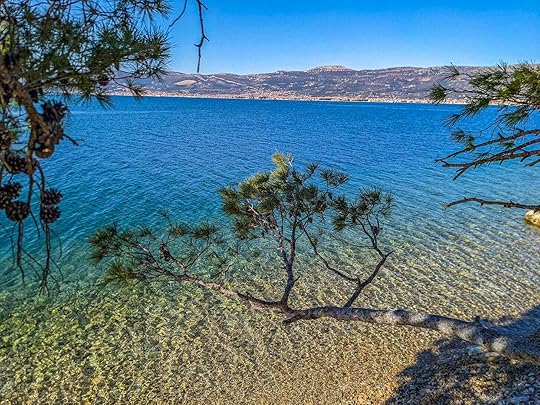 Not actually Australia. Or thirty feet. But you get the idea.
Not actually Australia. Or thirty feet. But you get the idea.Everyone else had already jumped — mostly, the other kids in the exchange program that had brought me to Sydney, Australia, for my senior year of high school. They waited in the water below, gently encouraging me to go for it.
I wanted to make the leap, but I was utterly terrified. I didn’t take risks like this. What if I landed wrong and hurt myself? What if I did the belly-flop heard around the world?
It felt like a test. Had my time in Australia changed me as much as I’d wanted when I’d first arrived? My stay as an exchange student was almost over, and if I didn’t jump now, it would feel like I’d failed that test.
I took a breath, stepped forward — and promptly spun back around, far away from the edge.
Need travel or international health insurance? We recommend Genki or Safety Wing. For a travel credit card, get 60,000 free miles with Chase Sapphire Preferred. Using these links costs you nothing and helps support our newsletter.
It’s the biggest travel cliché of all, how travel changes a person — makes them more confident and open-minded. Happier.
After five years of traveling the world as a digital nomad, I can happily attest that this is true. I know I’ve changed for the better.
However, not all travel is equally transformative. My time as a nomad has been fascinating and enriching. But living in Australia turned me into a completely different person — and maybe even saved my life.
At the very least, it saved me from a life that would’ve been horribly wrong for me.
 My junior year prom photo shortly before leaving for Australia. I didn’t want to go to prom but everyone insisted, and this lovely young lady agreed to be my date.
My junior year prom photo shortly before leaving for Australia. I didn’t want to go to prom but everyone insisted, and this lovely young lady agreed to be my date.Even now, I know my parents only wanted the best for me. Or what they thought was the best for me.
Unfortunately, that meant endlessly discouraging my dreams of becoming a writer, which they saw as a road to instability and poverty.
My mother pushed me to study the law, ostensibly because I liked to argue. My father wanted me to go into banking, his own profession — which, incidentally, he hated, and which always made this seem like such weird advice.
The thought of doing either profession gave me a stomach ache. So did their dreams of my getting married, buying a house in the suburbs, and having kids, though not for reasons I yet understood.
I was also overweight, and my parents wanted what was “best” for me here too.
My father forced me to play football for years, even though I hated it. Whenever my mother and I shopped for the “husky”-sized clothing I had to wear, she made humiliating comments in hopes that would finally prompt me to slim down.
It was 1981, and I was an introverted seventeen-year-old who loved books and hated the bleak future he saw stretched out in front of him — the conventional life he didn’t want. It’s no wonder I overate.
I needed something to knock me off of the trajectory I was on — something to bring about a massive change I couldn’t make on my own.
Where’s an asteroid when you need one? Because I desperately needed something to knock me into an entirely different orbit.
Luckily, an asteroid did hit me when I was chosen for that exchange program. I would finish my senior year of high school in Cronulla, a suburb of Sydney, Australia. My Aussie “parents” were Phil and Shân, who had immigrated to Australia from Wales more than fifteen years before.
I exchanged some letters with them and even chatted briefly on the phone.
Subscribed
 Me as a teenager. Oy!
Me as a teenager. Oy!When I finally landed in Australia and met Phil and Shân, they seemed completely different from my own parents and what I saw as their very conventional lives.
They’d immigrated to Australia, for one thing. Phil was an easy-going former airline mechanic turned milkman with a shaggy beard. And he rode a motorcycle! Meanwhile, Shân was a whip-smart, energetic, no-nonsense woman with very strong opinions.
The day after I arrived, Phil took me for a walk on the nearby beach. “So,” he asked me, “what do you want out of your visit here?”
I didn’t know how to answer — partly, because I wasn’t used to being asked what I wanted. The truth is, the life I wanted seemed so unattainable it wasn’t worth dreaming about.
I was able to tell him one thing I wanted: to lose weight.
“Okay,” Phil said. “Let’s see what we can do about that.” Somehow he said it in a way that didn’t make me feel bad about myself.
After that, he and Shân invited me on their evening walks. “Come on then, Michael!” Shân would say. “Let’s go!”
They also encouraged me to explore the rocky shore by myself.
The ocean frightened me — I definitely wasn’t adventurous — but Phil taught me how to bodysurf, which I absolutely loved. I started going for morning swims in the rock pool just below our house and even took up snorkeling.
To my amazement, I started to lose weight.
But this was the least of it.
One day, Phil asked, “Do you want to learn how to ride a motorcycle?”
I knew my parents would flip if I took a risk like that. And I was scared. Motorcycles were fast and loud and dangerous.
But I’d loved bodysurfing and snorkeling. Plus, I liked the idea of being someone who, you know, rode a motorcycle. Because overweight bookworm Michael would never do anything like that.
I went and had a great time. On another outing, Phil taught me to shoot a gun. Once, several of the other exchange students suggested four of us go camping in the Blue Mountains — without any adults. Phil and Shân said sure, which amazed me. Wasn’t camping without adults reckless and dangerous? I went and had a blast — and no one died.
Eventually, I told Shân my dream of becoming a writer. She didn’t act like the idea was ridiculous or tell me it was a foolish choice.
“If that’s what you want,” she said, “then you should do it. But just talking about it won’t make it happen.”
 Shân and I doing the washing up after dinner.
Shân and I doing the washing up after dinner.As I said, Shân was no-nonsense.
Over dinner another night, I talked about how much I didn’t want to go back home. That doing so meant I’d end up like my parents — my American ones, that is. I hated the idea of a 9-5 job and living in the suburbs.
“I think I might even want to live outside of America,” I said.
“Then you should,” said Shân.
“But my parents will be so angry.”
“Why?” asked Phil.
I thought for a moment, then said, “Because they’ll think I’m rejecting them and the way they live.” Which was true: I was rejecting them.
“It’s fine if a conventional life isn’t for you,” said Phil. “But there isn’t anything wrong with it either.”
“You can’t be responsible for how they feel about your life,” said Shân. “And you have to live your life the way you want or you’ll end up very bitter. But you can be as considerate of their feelings as possible.”
Phil nodded. “You just have to decide what you want and then do that.”
 Phil asking, “Which life would you like, Michael?”
Phil asking, “Which life would you like, Michael?”I know now that giving thoughtful, unbiased advice is easier to do with other people’s children.
But I still appreciated it, the way Phil and Shân seemed to see me for who I actually was. It felt incredibly liberating — and a bit frightening. After all, people I respected had now given me permission to go after my dreams. If I didn’t follow through, I couldn’t blame it all on my parents.
If I can lose weight, I thought to myself, maybe I can do the rest as well.
Of course, change is never easy, and life doesn’t usually move in a straight line.
My first year of college, I regained most of the weight I’d lost in Australia. And, because my father insisted, I majored in business, a subject that I loathed.
But being hit by the “asteroid” that was Australia — and Phil and Shân — really did change my trajectory in the end.
Between my freshman and sophomore year, I joined a gym, determined to lose the weight I’d gained and more. Almost forty years later, I can say I’ve kept it off.
I graduated with that degree in business, but tossed it in the trashcan the moment they handed me my diploma, and promptly moved back to Australia where I backpacked around the country and got a job working at the World Expo in Brisbane.
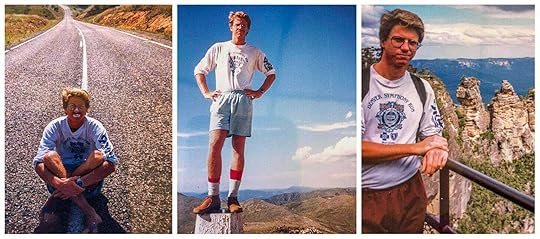 Me at age twenty-four, back in Australia.
Me at age twenty-four, back in Australia.Eventually, I landed in Seattle where I started my journey to becoming a writer. It’s also where I found the courage to finally come out, and I met my husband, Brent.
I’ve now been making my living as a writer for more than twenty years, though it hasn’t been easy. Maybe my parents had a point about that.
But they were wrong about almost everything else.
Remember how I started this? How I walked away from the edge of Australia’s Wattamolla Cliff — how I’d chosen not to jump.
There’s more to the story.
Yes, I walked away.
But I stopped again and thought about all I’d done in Australia — losing weight, riding a motorcycle, shooting a gun. I’d even gotten so drunk at a party, I’d wound up barfing in a bathroom. That might seem like a weird thing to be proud of, but it’s a teenage rite of passage the old Michael never would have done.
Then I turned around, walked back to the edge of the cliff, took a deep breath — and I jumped.
And I’m really, really glad I did.
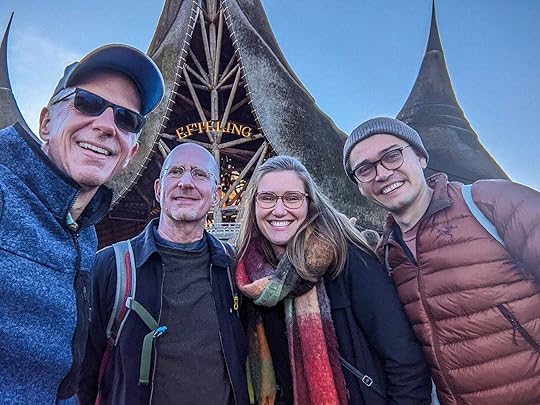 A much happier me, a writer now, traveling the world as a nomad, with Brent and some friends in the Netherlands last year.
A much happier me, a writer now, traveling the world as a nomad, with Brent and some friends in the Netherlands last year.Michael Jensen is a novelist and editor. For more about Michael, visit him at MichaelJensen.com.
Thanks for reading Michael’s Substack! Subscribe for free to receive new posts and support my work.
Never Forget: Meet Benny and Bella Schepsman, Holocaust Survivors
In our travels, Brent and I have met many interesting people. This week, we met Bella and Benny Schepsman, ages 96 and 95.
They’re both Holocaust survivors.
Thanks for reading Michael’s Substack! Subscribe for free to receive new posts and support my work.
 Me with the lovely Bella.
Me with the lovely Bella.“My brother Jacob and I were captured by the Germans along with other Jews,” Benny told me at one point. “Then they divided us into two groups. Jacob wound up with the group put on a cattle car and sent to Treblinka where he was gassed. Why him and not me?”
It was difficult to hear these horrible things, but it was obviously far more difficult to live them, and to have the courage to retell them even decades later.
But Bella and Benny are determined that all of the stories of their abuse at the hands of Nazi Germany be told. They don’t want the world to forget the 11 million people who died in concentration and extermination camps, nor the tens of millions more who died in the war.
Which was how I found myself in their apartment in Long Beach, New York, near where I had been visiting my friends Ellen Zwalsky and Marty Schepsman, their daughter-in-law and son.
For an hour, Benny and Bella recounted the bigotry they encountered, the beatings and illnesses they endured, the starvation they suffered, the years of slave labor making clothes and munitions for the Germans, the terrifying times they came dangerously close to being “liquidated,” and how much they missed their murdered family members.
“They took my sister and her newborn baby, our family’s first grandchild, away and murdered them,” Bella told me with tears in her eyes.
At the end of my visit, Benny looked me in the eye and asked “What is your interest in my story?”
 Benny’s older brother Jacob, taken away and murdered by the Germans.
Benny’s older brother Jacob, taken away and murdered by the Germans.When I later repeated my long-winded answer to Marty, he replied, “What you basically said is ‘never forget.' You don’t want people to forget injustice.”
He was absolutely right. I’d heard Holocaust stories before, studied the horror in school. I’d visited the Holocaust Museum, seen Schindler’s List, and read The Diary of Anne Frank.
But hearing these barbaric stories directly is different. It’s one degree of separation. Now I will truly Never Forget. This article is two degrees of separation, and maybe it will help others Never Forget too.
Benny and Bella both told me something else that has stuck with me: “The world knew and looked away.”
I think that’s an important part of Never Forget, something these survivors of the Holocaust really want us to know.
Here is more of Benny and Bella’s story of how they managed to survive.
Both Benny and Bella were from Poland, and were teenagers when the Nazis invaded. Benny came from a very poor family in Radom, Poland, and barely had enough food to survive, while Bella came from a middle-class family. But to the Germans and their fellow Poles, who mostly turned their backs on them, they were just “dirty Jews.”
When the Germans invaded Radom in 1939, the population was 95,000, including 35,000 Jews. By 1942, 32,000 Jews had been sent to Treblinka and murdered. That included all of Benny’s family, including his mother, sister, and her small two children who were taken into a field and shot — or “liquidated” — by the Germans. Two weeks later, Benny’s father suffered the same fate.
Nineteen-year old Benny was the last survivor of his family as he was forced to become a slave for the Germans.
Bella was from a middle-class family in Stopnica, Poland. She and her sisters were captured by the Germans in 1940. Not long after, Bella and her sisters Adele and Sara were forced into slave labor making munitions for the German Army. During their time as slaves, the Germans regularly took the ill prisoners, as well as others at random, and murdered them. One day, one of Bella’s younger friends was chosen just because she was in the wrong place at the wrong time. Bella could do nothing as her friend was lined up in front of an open pit.
A soldier said, “Why should we waste ammunition on you dogs?” and pushed Bella’s friend and the others into the pit, and buried them in dirt while they were still alive.
 Benny meeting his great grandson Rex. “Our children and grandchildren and great grandchildren are how we know we survived.”
Benny meeting his great grandson Rex. “Our children and grandchildren and great grandchildren are how we know we survived.”Afterward, everyone in the camps listened to the screams of the dying.
Over the following years, Benny and Bella survived countless horrors and deprivations. Time and again, they escaped being selected for “liquidation” by the Germans.
At one point, Benny was sentenced to 150 lashes, which nearly killed him. So much blood collected in his buttocks from the beating that a doctor had to make five incisions to let the blood drain down Benny’s leg and onto the floor. He received almost no other medial attention for his injuries, which became infected and constantly drained pus. Forced to trade what little food he had for a bandage, Benny nearly died from his injuries.
As the war drew to a close, the Germans forced their emaciated prisoners on death marches to try and keep them away from the Allies. When Benny was finally liberated by the Americans in 1945, he weighed 60 pounds, and it would take him months to recover from his physical injuries. Bella and her sisters were forced onto a similar march to Dachau in Germany, the purpose of which was to march them to death.
To make matters worse, Bella fell ill with typhus, which caused her glands in her neck to swell to the size of tennis balls. To save her life, a doctor cut slits in her neck, draining the pus into buckets. The typhus left Bella so incapacitated that she couldn’t walk. To keep her from being shot by the Germans, her sisters carried the rest of the way to Dachau, where they were to be murdered. But when they arrived at the camp, they discovered the war had ended and Dachau was liberated. Bella, comatose and near death, was sent to a hospital to recover, which was where she met Benny.
Benny was the only survivor from his family, while all that remained of Bella’s family was Bella and her two sisters. Benny and Bella were married on May 3, 1948, and a month later they were on their way to America. The early years there were a struggle but both were determined and hard workers, and eventually they established their own clothing business, and started a family that today stretches over four generations.
It was a pleasure and an honor to meet them both. I will carry their words and stories forward.
I will do my part to make sure we all Never Forget.
Note: Since this interview was originally published, both Benny and Bella have passed. Which makes me it even more important to tell their story.
Michael Jensen is a novelist and editor. For more about Michael, visit him at MichaelJensen.com.
Thanks for reading Michael’s Substack! Subscribe for free to receive new posts and support my work.



